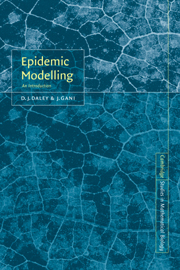6 - Fitting Epidemic Data
Published online by Cambridge University Press: 16 November 2009
Summary
When epidemic models are used in practice, it is essential to know how well they fit the available data. This is particularly important if reliable predictions are to be made, for example, of the number of AIDS cases to be expected during the next year. Comprehensive accounts of the fitting of various models to sets of epidemic data are given in Bailey (1975), Becker (1989) and Anderson and May (1991), among others. We have already illustrated how certain models were developed to explain observed data. In Chapter 1 we modelled Bernoulli's data in Table 1.3, reviewed Abbey's work on Aycock's data in Table 1.5, and gave Enko's data in Table 1.6 (see Exercise 1.3) and Wilson and Burke's Providence RI data in Table 1.7 (see Exercise 1.4). Further examples were given in Section 2.8 (Saunders's data on rabbit populations affected by myxomatosis) and Section 4.2 (Enko's measles data again). This chapter provides a more extensive discussion of epidemic data fitting: we illustrate its principles with five simple examples, two in which the models are deterministic, and three in which they are stochastic. Readers seeking further details are referred to the previously mentioned books.
In a sense, this chapter serves to introduce the succeeding, final chapter which considers the control of epidemics: how can we use an epidemic model to evaluate possible strategies for countering a particular epidemic phenomenon? Simple models typically start with an elementary scenario; this may be modified subsequently to bring the model closer to the real-world context in which the phenomenon is occurring. For example, in most epidemics, those gathering the data may assume a given initial scenario, which is later changed.
- Type
- Chapter
- Information
- Epidemic ModellingAn Introduction, pp. 154 - 174Publisher: Cambridge University PressPrint publication year: 1999

